
|   |

|   |
 e-mail: ukb7@rediffmail.com Of dancing gene and Varnam mime Photos courtesy the artistes January 22, 2020 Did man's not-too-distant animal forefathers have a sense of rhythm and like to dance to music? It would certainly seem so, as the latest research at Kyoto University suggests, from their experiments with seven chimpanzees who, incidentally, have as many as 93 per cent (perhaps more) of genes in common with their human progeny. Although none of the primates had been taught to groove and received any rewards for doing so, they still broke out into spontaneous movement -- by clapping hands, tapping feet and swaying along - when played bursts of tunes on piano! The consummate way in which both nritya and nritta of Indian classical dances are linked to the geetam and vadyam of the land, appears to recognize this heritage, in being beautifully integrated in their conceptualizations and aesthetics, as well as in their manifestation, as it struck this critic once again, while watching some of the recent dance performances in the eastern metropolis. Darpanee Festival 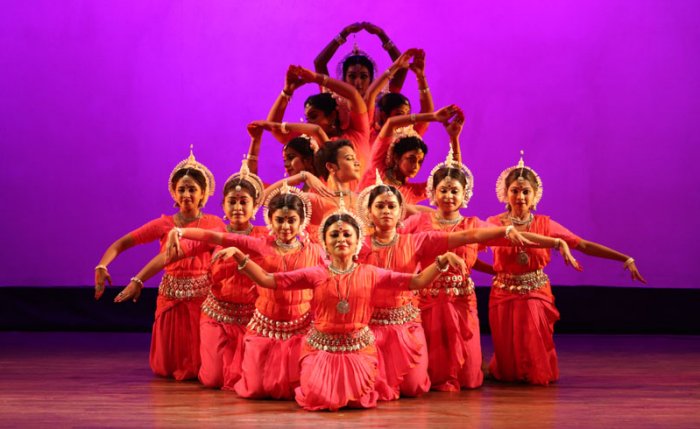  Arnab Bandyopadhyay's group Presented on December 26 by 'Darpanee', their director Arnab Bandyopadhyay - a senior dancer in Bharatanatyam and Odissi - showed a great flair in choreography right from the word go. In the opening item of Vishnu Vandana, twelve female dancers along with one male, entered from the auditorium to welcome the audience with rose petals before trikhandi pranam. While generally maintaining traditional pattern, the lead male dancer alternated between Vishnu and his disciple in a fluid form. Stress was laid on circularity, with opening and closing of floral forms to execute the divine ambience. Next was a Bageshree Pallavi (known popularly as Yugmadwanda Pallavi), remarkable for its geetam by the iconic musician Damodar Hota that maintained throughout an alternating structure of point and counterpoint as between jatis and swaras, between their changing tempi, and a cascading of both in fast sawal-jawab mode. In sync with the music, the choreographer used separate groups for the long prelude and for the main choreography where five girls reverberated with asymmetric patterns. The abstract composition came through very well using bhangis and mudras with various instruments. Finally came Jayadeva's Dashavatar with music by Pt. Bhubaneswar Misra, lyrical and full of meends (glides), but not very contrapuntal in their flow. This was mirrored with great dramatic effects to build choreography around the incarnations with different legends behind them, with an interplay of moods and emotions till the very end. 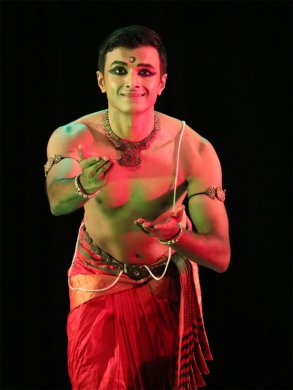 Parshwanath Upadhye This was followed with Bharatanatyam by Bangalore based Parshwanath Upadhye who burst on the Kolkata stage quite as a revelation. Trained by various gurus and recently under the tutelage of guru Sudharani Raghupathy, Parshwanath began with Chamundeswari Vandana. He selectively used Mysore bani which was very distinctive. Then came his spectacular Varnam in raga Behag and set to adi talam, eulogizing Krishna in various stages of life. His most evocative mimes -- transcending the usual sattvikam of his dance - created a new world of visual splendor, of Makhan Chori, Kaliya Daman and especially Vishwaroopa Darshana. Set to a Kriti by saint-poet Kanakadasa, this was a tour de force. So was the next item Devangana, also based on a Kanakadasa's Kriti, set to ragamalika. Abhinaya here hovered between dream and reality of the devotee and his ethereal bonding with Baro Krishnaiya. Parshwanath captured the spectators' hearts all through! Yugasandhi and Lei Pareng Presented on January 2 by 'Nandanik Movement Arts', the festival showcased in the first segment, young and aspiring talented classical dancers- without having to make any payments. An interesting prelude was provided by Dr. Aditi Bandyopadhyay, an Odissi dancer and an eminent authority in neurological sciences, with extended exposure to critical medical care and autism in the USA and in private hospitals in India. She provided an incisive insight into dance therapy with a band of autism-challenged youngsters performing impromptu therapeutic movements in dance, with great enthusiasm and admirable sense of participation. 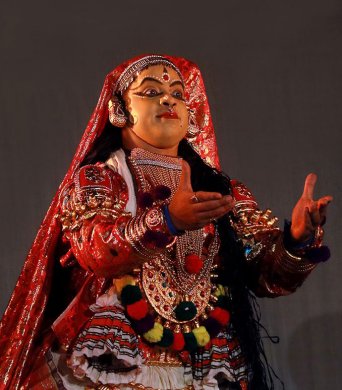 Prolay Sarkar 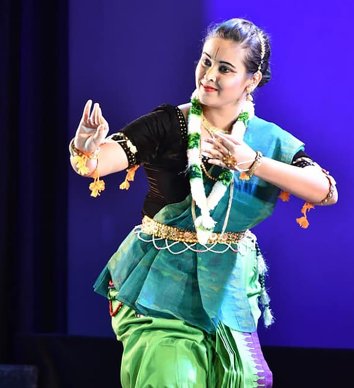 Priyanka Talukdar Prolay Sarkar, a young Kathakali dancer with enviable exposure in India and abroad, took the stage then with Putana Moksham in stree vesham. Enacting the well-known episode of the demon Putana - taken from Harivamsham - Prolay was quite convincing in showing his prowess as a female associate under Kamsa's command to kill the young new-born in Gokul and meeting her nemesis when she tries to suckle the baby Krishna at her poisoned breasts. Next came Priyanka Talukdar, a young Manipuri dancer with good grooming and extensive dance experience, to perform Brahmatala Prabandha, a composition showing Krishna's participation in Rasleela. The item demonstrated vigorous tandava, intricate rhythmic patterns and expressive abhinaya with Radha and other Gopis. The composition was, in essence, an amalgam of different talas in the same composition: Dui Tala Macha in 12 beats; Brahmatala in 28 beats and Tala Menkup with 6 beats, along with their appropriate stresses. This, incidentally, was an ample demonstration of accompanying vadyam in Manipur ranging from the percussion Pung to the string Pena, amidst many others. Priyanka won her audience's heart with her winsome presence. At the end appeared Shamila Bhattacharya in Kathak. Groomed early by Rani Karnaa and also with a Masters in Kathak from Rabindra Bharati University, Shamila presented a novel item, Chaturang, comprising Sahitya, Sargam, Tarana and Trivatt. Built around the dalliance of Radha and Krishna alongside the Gopis performing Rasayatra with abandon in the groves of Vrindavan, the accompanying music used ragamalika and talamalika, starting with Yaman in Jhaptal (10 beats); Hamir in Teentaal (16 beats); Kedar in Dhamar (14 beats) and ending with Bilawal in Ektaal (12 beats). 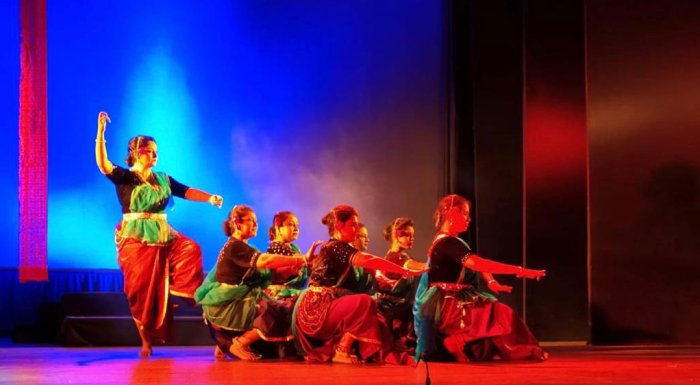 Poushali Chatterjee's group In the second segment, Nandanik's artistic director Poushali Chatterjee - a very senior Manipuri dancer -- came on stage along with her group to perform Gaurchandrika, sung by guru Kalavati Devi as an invocation to Shri Chaitanya who set off the Vaishnava movement in Bengal and the entire eastern region. The music was set in the Kokilapriya tala (36 beats), marking the auspicious beginning of Sankeertana and Raasleela in the Raas Mandap. Then came the main program Lei Pareng, highlighting some of Bipin Singh's rare compositions in Manipuri. The first was Krishnaroop Varnan, collated from Vaishnava Padavali in tala Kankan (11 beats) of Singh's own creation. This was followed by Tanchep tala (4 beats) and then Teentaal, Mel and Chali. The second piece was Sakshat Darshan danced solo by Poushali, allowing her ample scope given by Oja Bipin, to convey Radha's heartache, restlessness and embarrassment about Radha's describing her first encounter with Krishna to the companions Lalita and Vishakha. The Bengali vocal was sung by her mother Atashi Chatterjee. The third item was Pung Vadan by Poushali with four female dancers, as a unique deviation from the usual male preserve of Pung instrument that Oja Bipin permitted to his female disciples, complete with all the accompanying head and torso movements that the male players perform. Rendered in tala Dashkosh (7 beats), it was a rare sight. Nritya Katha 2020  Voices from the Past  Shrabani and Pratibha Biswas 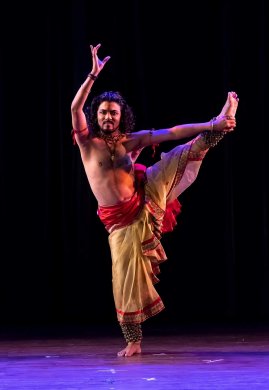 Rahul Deb Presented on January 6 and 7 by Jailal Academy of Music, an institution rendering yeoman's service to the cause of Jaipur gharana of Kathak in Kolkata, they followed the legacy of Pt. Jailal and Pt. Ramgopal Mishra. The programme began on January 6 with Voice from the Past, a fascinating audio-visual presentation of their heritage percussion and bol-parhants, punctuated by dance of senior students of the Academy. Next, Shrabani and Pratibha Biswas, two young and talented students of guru Ramaprasad Chattopadhyay, commenced with a Krishna Vandana followed by intricacies and details of Vilambit (9 beat) where they presented lari, aamad, tora, paran and tihai. Switching over to drut teental (12 beat), they presented tora, aamad, paran and tihai. Then came a Tripura based rising Kathak dancer Rahul Deb trained by Bhaswati Misra and Arjun Mishra, among others, with solo Kathak. Commencing with a Shiv Vandana, he switched over to vilambit teentaal with intricacies of lari, upaj, thaat, ang ki aamad and tukra. He concluded his recital with a Krishna Bhajan in Dadra taal.  Sucharita Datta 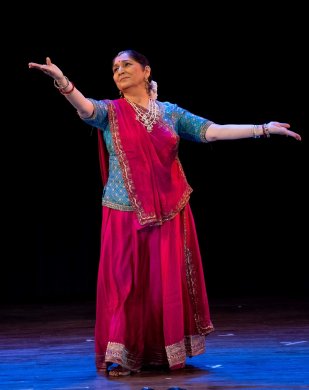 Uma Dogra The next solo was presented by a senior dancer Dr. Sucharita Datta Gupta - trained by Susmita Mishra in Jaipur Gharana and by Pt Birju Maharaj in Lucknow Gharana - who rendered first a short Shiva Stuti. Moving on to taal Dhamar, she presented thaat, upaj, tukda, paramelu, parhant, tihai and tatkar. She concluded with a scintillating thumri by Birju Maharaj, Kahe bharata gagariya savariya in Dadra taal. The apt finale was by Uma Dogra of Jaipur Gharana - disciple of Pt. Durgalal - who commenced her recital with Vallabacharya's Madhurashtakam Stotra in raga Bhairavi. Thereafter she presented some well-known compositions of thaat and aamad in vilambit teentaal. She was accompanied by her able disciple Indrayanee Mukherjee in taal portion with a lot of taiyari and grace. Uma concluded with a famous ashtapadi by Jayadeva, Sakhi he kesi madana mutharam in raga Shudha Sarang. The second evening on January 7 began with Tanmayee Chakraborty - disciple of Keya Chanda -- with a Shiva Vandana, Shambhu Maheswara... Her nritya paksh comprised both Jaipur and Lucknow Gharana, presenting parans and tukras in teentaal, such as, Bijli Parhan, Kandook ki Parhan, Ghodsawar Parhan, Chakradhar Toda, etc. She also presented a small, but beautiful kavit in Jaipur Gharana to show Radha-Krishna dalliance. She concluded with a ladi and chakkar. Next came a talented young dancer Manab Parai, groomed by Guru Madhumita Ray, who began his program with Karpuri Gaurav, an ode to Shiva. His nritya paksh went with 10 ½ beat, with traditional thaat, upaj, parhan, ladi, aamad, toda and tihai. He concluded his performance with tihai, parhan and sawal jawab in drut teentaal.  Manab Parai 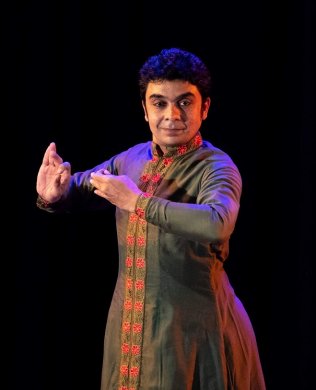 Vikram Iyengar Vikram Iyengar, a respected name in national and international Kathak scene, was the next to follow. Among the senior most disciples of Guru Rani Karnaa, Vikram began with Krishna Saundarya Varnan in Ragamalika and rupak taal, followed by Chakra Dharan in raga Hindol and sool taal. Both these were executed with great poise and beauty. His reposeful presentation followed this with some unique teentaal compositions of Jaipur Ghrana like thaat, aamad and parhan in drut and vilambit layas. He concluded with a very evocative ghazal, Zindegi jabvi teri bajme lati hai... Next to come was Manisha Mishra, daughter of tabla exponent Ravinath Mishra, who seemed more inclined to Banaras Gharana than Lucknow Gharana of Arjun Mishra that she was introduced to follow. Holding a Ph.D degree in Kathak, she began with an ode Narayani Namohstute…, to depict multiple manifestations of both Durga and Kali. She then presented her taal paksh in teentaal, with upaj, thaat, tora, parmelu and jugalbandi. Manisha particularly relished showing off her andaaz of a horse rider, a lion chasing a deer, and a frightened deer. She concluded with a presentation with Dadra taal on Radha-Krishna love-play, Jao kanha, karo na mujhse raar re… 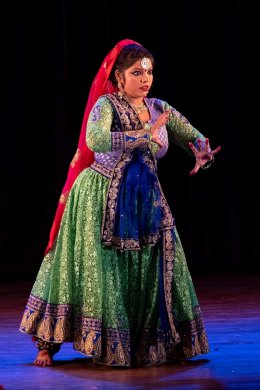 Manisha Mishra 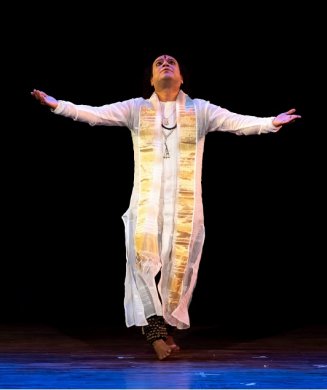 Ashim Bandhu Bhattacharya Ashim Bandhu Bhattacharya provided the grand finale. A very senior dancer - disciple of gurus Susmita Mishra and Vijay Shankar - he began with an Adi Shankaracharya hymn on Nirvana Ashtakam set to raga Pramashri and jhaptaal. This was followed by his teentaal presentation of upaj, thaat, aamad, tukra, tora and crisp footwork in both Jaipur and Lucknow gharana. As has been noted by this critic on earlier occasions, Ashim Bandhu's forte is use of sharp lighting and imaginative properties to highlight innovative items. As was his custom, he concluded with a beautiful Urdu Nazm (verse sans rhyme) that highlighted a lover's anguished recollection of his beloved's letters and ending those shredded now to float away with the river's flow. Accompanied with a solitary lamp and a designer shawl carrying the torn letter pieces, the abhinaya was very evocative. All the dancers were accompanied individually by competent instrumental and vocal support, but their listing is withheld her to save space.  Dr. Utpal K Banerjee is a scholar-commentator on performing arts over last four decades. He has authored 23 books on Indian art and culture, and 10 on Tagore studies. He served IGNCA as National Project Director, was a Tagore Research Scholar and is recipient of Padma Shri. Post your comments Please provide your name and email id when you use the Anonymous profile in the blog to post a comment. All appropriate comments posted with name and email id in the blog will also be featured in the site. |